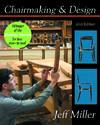

| Publisher | The Taunton Press |
| Year | 1997 |
| ISBN | 1-56158-158-5 |
| Pages | 200 |
Ken Greenberg
First, I wish to note that the edition being reviewed is the 1979 version; it has a different cover from the current version shown above.
Let's get the bad news out of the way first. Despite his occasional use of a hand plane, Jeff Miller seems to believe that the most useful tool for joinery is a plunge router and a big collection of jigs for using it. For those of us who have made a good number of mortise and tenon joints, this isn't a problem. Ignore it and do things your way. It just gets tedious after a while. While some of the joinery presents an interesting challenge - joints at angles other than 90 degrees are common in chair making - it's nothing that you can't overcome with a bit of patience. I did it, and so can you.
I originally borrowed this book from the library because I had just designed and prototyped a dining chair. I sent a picture of it to a non-woodworking friend with the explanation that I was working out some comfort issues, and he asked if there were standards for chair design. A search of the old tools archives led me to this book, which answered my questions and suggested that I have a long way to go in this area. But it will be fun.
I like books that take you through the learning experience by starting with something that you know how to do and building on that one project at a time. Each adds some new design element and some additional complexity to the project. Whelan's book on making wooden planes is like that, and so is this book. You may not build everything in the book, but you can see how things move from the simple to the complex in reasonable steps.
Miller starts out with the basics of chair design - comfort, durability, and appearance and the tradeoffs between them. This includes such areas as function, dimensions, shape, joinery, stretchers, arms, grain orientation, and so on. He next presents a gallery of chairs my various makers (including some of his own) to show what kinds of things are possible. In Chapter 2, he covers chair making basics in somewhat more detail. There's a good deal of information on joinery and shaping. Of course, much of this involves the router, but there is still much to be learned.
In chapter three, a detailed description of a dowel chair is presented. Probably few readers will attempt to make this chair, but it's an interesting way to learn about ergonomics. It is all too easy to make an uncomfortable chair; this chapter can teach you a great deal about how to make a chair that feels right, despite looking rather odd.
Chapter four moves on to a very basic chair that many people will (or should) make, as it teaches you the basic steps in making a chair. In fact, this "right-angle chair" is quite similar to my dining chair design, except that I do use a curved backrest for my chairs. Looking at flat backrests makes my back hurt - but they are simple. Here you will learn about the proper relationship of chair elements - the rails, the front and back legs, and the stretchers. You also learn a bit about how seats are made (mine is quite different, but his is more conventional). If you successfully build the chair in this chapter, you can call yourself a beginning chair maker. Everyone has to start somewhere, and you will have learned most of the basics at this point.
Subsequent chapters then take you through a number of designs to improve your skills. While the right-angle chair is square, most chairs taper so that the back is narrower than the front. This changes the way mortise and tenon joints are made. You will learn about making chairs with vertical back slats between a pair of rails. You then move on to shaped legs and rails and curved back slats. He then takes you through the steps for making a "cafe chair" with a laminated U-shaped rail. The next step is to make a chair with a carved-out wooden seat, instead of an upholstered slip seat. The legs here are attached to the plank seat, in the Maloof style. Finally, he takes you through armchairs, and the different ways they can be made.
If you are at all interested in chair making, this book will teach you much of what you need to know. I expect to buy a copy one of these days, probably when I am finished with my dining chairs (I'm pretty happy with the design) and ready to move on to something a bit more graceful.